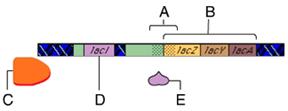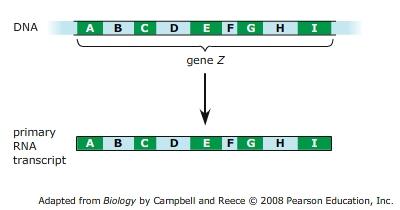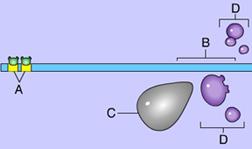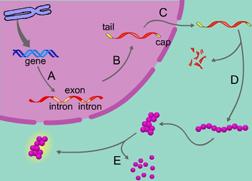Which of the following statements best defines the term operon?
An operon is a region of DNA that codes for a series of functionally related genes under the control of the same promoter.
What molecule binds to promoters in bacteria and transcribes the coding regions of the genes?
RNA polymerase
What is allosteric regulation?
In allosteric regulation, a small molecule binds to a large protein and causes it to change its shape and activity.
Under which conditions are the lac structural genes expressed most efficiently?
No glucose, high lactose
What happens to the expression of the lacI gene if lactose is not available in the cell?
There is no change—the lacI gene is constitutively expressed.
What is the function of the lacZ gene?
This gene encodes an enzyme, b-galactosidase, which cleaves lactose into glucose and galactose.
Which of the following enzymes converts ATP to cAMP?
Adenylyl cyclase
True or false? The mechanism by which glucose inhibits expression of the lac structural genes is known as catabolite stimulation, whereas the mechanism by which lactose stimulates expression of the lac structural genes is known as allosteric regulation.
False
The process by which lactose binds to the lac repressor and inactivates it by causing it to change shape is known as allosteric regulation. However, the process by which glucose causes cAMP levels in the cell to drop, thereby preventing CAP from stimulating expression of the lac structural genes, is known as catabolite repression.
The operon model of the regulation of gene expression in bacteria was proposed by _____.
Jacob and Monod
Which of these is NOT a component of the lac operon?
regulatory gene only
Regulatory proteins bind to _____.
the operator
In the presence of a regulatory protein the lac operon is _____.
not transcribed
The regulatory protein of the lac operon is a repressor.

In this animation the blue sphere represents _____.
lactose
Lactose inactivates the repressor protein so that the lactose-utilization genes can be transcribed.
In this animation the orange object represents _____.
RNA polymerase

Which of these is a regulatory gene?
D
Why is the lac operon said to be an inducible operon?
When allolactose is present, it induces the inactivation of the lac repressor.
Which statements about the modification of chromatin structure in eukaryotes are true?
Some forms of chromatin modification can be passed on to future generations of cells.
Acetylation of histone tails in chromatin allows access to DNA for transcription.
Acetylation of histone tails is a reversible process.
DNA is not transcribed when chromatin is packaged tightly in a condensed form.
Methylation of histone tails in chromatin can promote condensation of the chromatin.
Which statements about the regulation of transcription initiation in these genes are true?
The fantasin gene will be transcribed at a high level when activators specific for control elements A, B, and C are present in the cell.
Control elements C, D, and E are distal control elements for the imaginin gene.
Both the fantasin gene and the imaginin gene will be transcribed at high levels when activators specific for control elements A, B, C, D, and E are present in the cell.

Which of the following choices represent mRNA molecules that could be produced from the primary RNA transcript by alternative RNA splicing? (In each choice, the yellow part on the left represents the 5' cap, and the yellow part on the right represents the poly-A tail.)

ACEI
ACEGI
_____ bind(s) to DNA enhancer regions.
Activators
What is the event that IMMEDIATELY follows the last event of this animation?
binding of RNA polymerase to the promoter

Which of these indicates an enhancer region?
A
This is an enhancer region.
Which of these directly bind(s) to the promoter?
C and D
Both RNA polymerase and transcription factors bind with the promoter.

The process of transcription is indicated by the letter _____.
A
Transcription is the process by which information encoded in DNA is converted to information encoded in RNA.
The letter E is indicating a process of gene expression that involves _____.
protein breakdown
RNA processing is indicated by the letter _____.
B
As you can see, introns have been removed and a cap and a tail added to the RNA molecule.
Which of the following processes is NOT indicated by the label A, B, C, D, or E?
DNA unpacking
This process is indicated by the arrow that precedes arrow A.
Enzyme complexes that break down protein are called _____.
proteasomes
The nuclear membrane's role in the regulation of gene expression involves _____.
regulating the transport of mRNA to the cytoplasm
What is the function of a spliceosome?
RNA processing
Protein-phosphorylating enzymes' role in the regulation of gene expression involves _____.
protein activation
Proteins are often activated by phosphorylation.
DNA methylation is a mechanism used by eukaryotes to do what?
inactivate genes
In humans, the hormone testosterone enters cells and binds to specific proteins, which in turn bind to specific sites on the cells' DNA. These proteins probably act to do what?
help RNA polymerase transcribe certain genes
It is possible for a cell to make proteins that last for months; hemoglobin in red blood cells is a good example. However, many proteins are not this long-lasting; they may be degraded in days, hours, or even minutes. What is the advantage of short-lived proteins?
Short-lived proteins enable the cells to control their activities precisely and efficiently.
miRNAs can control gene expression by what action?
binding to mRNAs and degrading them or blocking their translation
Which of the following would be most likely to lead to cancer?
amplification of a proto-oncogene and inactivation of a tumor-suppressor gene
All your cells contain proto-oncogenes, which can change into cancer-causing genes. Why do cells possess such potential time bombs?
Proto-oncogenes are necessary for the normal control of cell growth and division.
If a particular operon encodes enzymes for making an essential amino acid and is regulated like the trp operon, then
the amino acid acts as a corepressor.
Muscle cells differ from nerve cells mainly because they
express different genes.
Which of the following is an example of post-transcriptional control of gene expression?
the removal of introns and alternative splicing of exons
What would occur if the repressor of an inducible operon were mutated so it could not bind the operator?
continuous transcription of the operon's genes
Within a cell, the amount of protein made using a given mRNA molecule depends partly on
the rate at which the mRNA is degraded.
Proto-oncogenes can change into oncogenes that cause cancer. Which of the following best explains the presence of these potential time bombs in eukaryotic cells?
Proto-oncogenes normally help regulate cell division.
Which statement(s) about inducible operons is/are correct?
In an inducible operon, the repressor is synthesized in an active form.
In an inducible operon, an inducer inactivates the repressor.
Which statement(s) about repressible operons is/are correct?
Repressible enzymes generally function in anabolic pathways.
A repressible operon is on unless a corepressor is present.
Which of the following best describes siRNA?
a short double-stranded RNA, one of whose strands can complement and inactivate a sequence of mRNA